
|
<<Back |
Luxembourg
Nov.
30 - Dec. 2, 2009 |
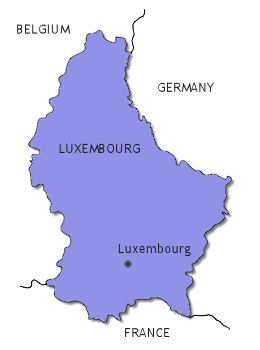
|
|
|
| We took a week off to visit
D’s parents in Germany. Much like our visit to Nürnberg
last year, we wanted to take a few days to see something
new and give D’s folks a short break from hosting duties.
This time we didn't want to wander too far from home,
so we decided to visit the neighboring country of Luxembourg.
Despite the fact it is only a 90 minute drive away,
getting there by train takes a couple hours and is actually
quite convoluted unless you take the final leg by bus. |
|
|
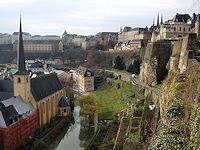
A view of the Alzette valley
|
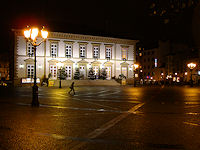
Luxembourg's Hôtel de Ville
|
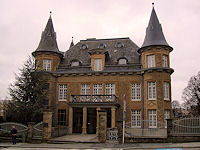
Villa Pauly
|
|
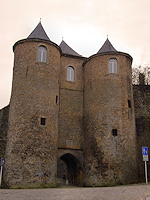
Three Towers Gate
|
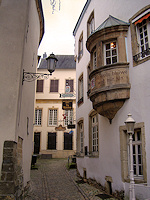
Rue de la Loge
|
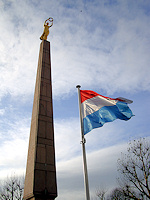
Gëlle Fra
|
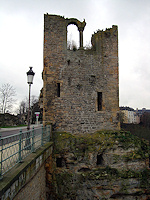
La Dent Creuse
|
|
|
While one of Europe’s smallest
nations at just under 1,000 square miles, Luxembourg
is also consistently one of Europe’s richest with
traditionally strong steel and banking industries.
Nestled between Belgium, Germany, and France, it has
German and French as official languages as well as
Luxembourgish – a German dialect. The origins of the
city of Luxembourg date to the Roman occupation of
the intersection of two trading routes on a promontory
that overlooked the Pétrusse and Alzette rivers.
After the fall of the Roman Empire and the subsequent
division of Charlemagne’s kingdom, the Roman fort
Lucilinburhuc (from which the name Luxembourg
is derived) built on the Bockfiels was acquired by
Count Siegfried of the Ardennes. Siegried fortified
the site with a castle in 963. Over the centuries,
further defenses were built as control of the area
passed between the Burgundians, French, Spanish (who
began building the 14 miles of tunnels in the Bockfiels),
the Austrians, the Dutch, and the Prussians. In addition
to the tunnels, Luxembourg had three lines of defenses,
a citadel, and more than 20 forts earning it the nickname
of "Gibraltar of the North".
After the defeat of Napoleon,
the state of Luxembourg was given autonomy but a land
swap with Prussia established rule of the territory
by the Netherlands which granted it status as a Grand
Duchy under William I. The Prussians however kept
a military presence in the city of Luxembourg. As
Prussia’s influence in the area grew, the French attempted
to enter into a deal for possession of the city resulting
in heightened tensions and the threat of war. The
Treaty of London in 1867 diffused the situation by
reaffirming the rule of the Netherlands over the Grand
Duchy and pledging Luxembourg’s permanent neutrality.
To this end, the Prussians withdrew, and the fortifications
were demolished over the next 16 years allowing the
city to expand its borders. It was not until 1890
that Luxembourg became an independent country with
Grand Duke Adolphe as its sovereign and Luxembourg
City as its capital.
In a more recent chapter of
Luxembourger history, the nation was a founding member
of the European Union in 1957. A plateau northeast
of the city known as Kirchberg now hosts the European
Court of Justice and the offices of the European Parliament
among other key buildings. We took a bus across the
Red Bridge and hopped off at the visually impressive
Luxembourg Philharmonic and to Fort Thüngen which
once defended Luxembourg from the other side of the
Alzette River. A walk along the old ramparts provided
panoramic views of the old city while we were serenaded
by a cacophony emitted from randomly placed loudspeakers
representing some sort of Euro-modern audio art. We
followed a path up the hill through several construction
sites which prompted disapproving looks from a number
of workers. It seemed that several new massive office
buildings were under construction indicating that
the EU might not be feeling the same economic pinch
as the US. The European Parliament building itself was
little more than a shiny collection of offices but
it was the point at which we could catch the bus back
to town.
|
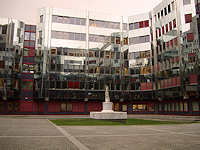
European Parliament

Pont Adolphe and the National
Bank
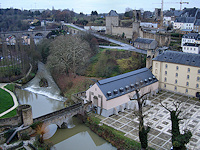
Wenceslaus Wall
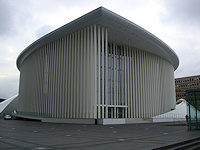
The Philharmonie
|
|
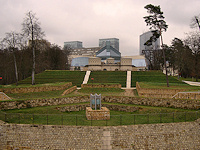
Fort Thüngen
|
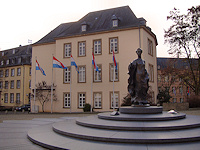
Place Clairefontaine
|
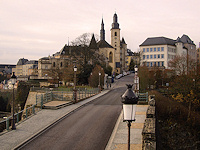
A view from the Bockfiels
|
|
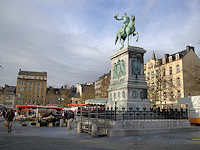
Place Guillaume II
|
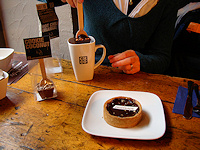
Hot chocolate break
|
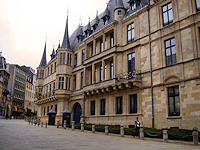
Grand Ducal Palace
|
|
|
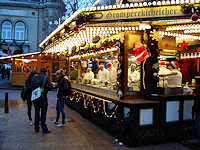
Scoring some gromperekichelcher
|

Luxembourg's Christmas market
|
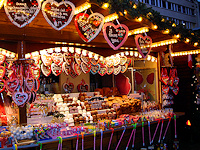
Christmas confections
|
|
|
Entering the Place des Armes,
we happened upon the city’s Christmas market. Although
smallish as big city Christmas markets go with about
two dozen stalls, it was a wonderful mixture of marché
de Noël and Weihnachtsmarkt. The
stalls to the outside sold the typical crafts, ornaments,
and confections while the inner stalls selling food
and drink surrounded a large canopied area for noshing
with fellow revelers. We had already spent some time
looking at the menus displayed outside of a number
of restaurants, but they were a little fancier and
more expensive than what we had in mind. Instead,
we focused on the brasseries which tend to
have simpler food and casual atmosphere. But here
around the Luxembourg old town, we couldn’t find anything
to meet our taste, so the Christmas market seemed
like as good a place as any to have dinner. Many of
the standards like red and white mettwürste,
marguez, and frikadellen were there,
but other treats such as raclette and fondue
were also available. We split a plate of spätzle
tossed with bacon and doused with cheese fondue
then went back for something more. We ended up sampling
true Luxembourger gromperekichelcher – deep
fried shredded potato patties mixed with herbs and
onions. Having already had our share of glühwein
before leaving Germany, we washed down our dinner
with Bofferding Christmas beer and a glass of Poire-Williams.
|
|
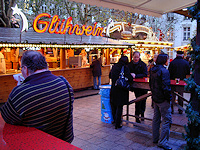
The beverage center
|

Craft stalls
|
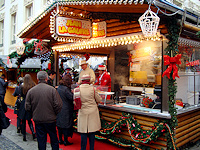
Belgian waffles
|
|
|
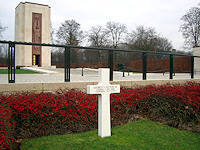
Patton's grave
|

The American Military Cemetery
|
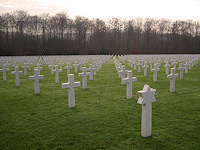
Field of fallen heros
|
|
|
On the outskirts of Luxembourg
City near the village of Hamm is one of fourteen American
military cemeteries located outside the United States.
This particular one is best known for containing the
gravesite of General George Patton. After a fatal car
accident in 1945, Patton was laid to rest here among
the 5,000 soldiers who lost their lives in and around
the Ardennes during the Battle of the Bulge.
Despite some bad information
off the Web on how to get there, we could only find
a bus that would take us as far as the center of Hamm.
From there it was only a mile or so to the cemetery,
but road construction forced us to make our way through
a highway exit roundabout and to trudge along a four-lane
main road to find the entrance. The irony of risking
our lives to visit a cemetery did not go unnoticed.
Relieved to reach our destination in one piece, we
spent a great deal of time reading the information
plaques and strolled around the paths delineating
the various plots. On such a gloomy day and only days
before the 65th anniversary of the battle, the seemingly
endless array of crosses and stars made for a meditative
and somber mood.
Bolstered from our recent trek
along Hadrian’s Wall, we decided to walk another mile
or so to the German military cemetery in Sandweiler.
The first of its kind on foreign soil, the German
cemetery is somewhat smaller than its American counterpart.
However, each stone cross actually represents four
fallen soldiers, meaning that the total number of
dead honored at Sandweiler is just shy of 11,000.
At the foot of the large stone cross memorial centerpiece,
there were flower arrangements left from the recent
November 11th ceremonies. We were pleased to see that
one of the large wreaths was attributed to the US
Embassy.
|
|
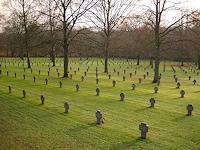
Soldiers buried four to a grave
|
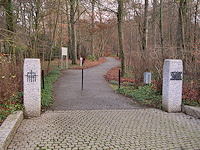
The German Military Cemetery
|

Mass grave memorial
|
|
Copyright © 2005 JnDsTravelog.com. All rights reserved. |
| |